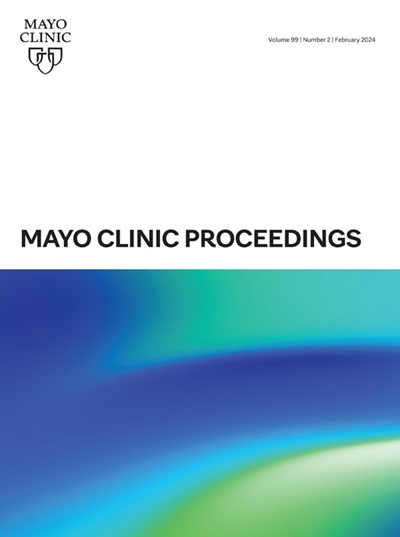Acute Effects of Myeloperoxidase Inhibition on Exercise Hemodynamics in Heart Failure With Preserved Ejection Fraction: A Randomized Clinical Trial
IF 6.7
2区 医学
Q1 MEDICINE, GENERAL & INTERNAL
引用次数: 0
Abstract
Objective
Myeloperoxidase (MPO) is a heme peroxidase that scavenges nitric oxide and contributes to microvascular dysfunction. Patients with heart failure and preserved ejection fraction (HFpEF) have microvascular dysfunction that leads to increased pulmonary capillary wedge pressure (PCWP). We sought to investigate whether acute MPO inhibition can reduce exertional PCWP in patients with HFpEF.
Patients and Methods
Between July 1, 2018, and February 24, 2022, participants with HFpEF were recruited. They underwent baseline invasive hemodynamic exercise evaluation and were then randomized, double-blind, to a single dose of the MPO inhibitor mitiperstat at 30 mg or matching placebo, after which they underwent repeated invasive hemodynamic exercise testing. The primary end point was PCWP during 20-W exercise workload.
Results
Patients with HFpEF (N=30; mean ± SD age, 70±9 years; 11 female [37%]; body mass index, 34.0 kg/m2) displayed typical hemodynamic responses to exercise prior to treatment, with PCWP increasing from 17±5 to 32±6 mm Hg with exercise and mean pulmonary artery pressure increasing from 28±9 to 49±11 mm Hg. Contrary to our hypothesis, as compared with placebo, mitiperstat treatment resulted in a higher PCWP during the second bout of exercise (−1±3 vs −4±5 mm Hg; P=.04). There was a trend for less reduction in mean pulmonary artery pressure and lower pulmonary artery compliance during exercise with mitiperstat as compared with placebo. There was no effect of mitiperstat on arterial, coronary sinus, or transcardiac uptake/release of O2, CO2, and lactate compared with placebo.
Conclusion
Acute MPO inhibition with mitiperstat did not reduce exertional hemodynamic congestion in patients with HFpEF.
髓过氧化物酶抑制对保留射血分数的心力衰竭患者运动血流动力学的急性影响:一项随机临床试验。
目的:基于髓过氧化物酶(MPO)是一种清除一氧化氮并导致微血管功能障碍的血红素过氧化物酶这一事实,探讨急性髓过氧化物酶(MPO)抑制是否能降低心力衰竭伴射血分数保留(HFpEF)患者的肺毛细血管斜压(PCWP)。心力衰竭和保留射血分数(HFpEF)患者存在微血管功能障碍,导致肺毛细血管楔压(PCWP)升高。我们试图研究急性MPO抑制是否可以降低HFpEF患者的运动PCWP。患者和方法:在2018年7月1日至2022年2月24日期间,招募了HFpEF患者。他们接受了基线侵入性血流动力学运动评估,然后随机、双盲地接受单剂量30毫克MPO抑制剂米特帕司他或匹配的安慰剂,之后他们进行了反复的侵入性血流动力学运动测试。主要终点为20-W运动负荷时的PCWP。结果:HFpEF患者(N=30;平均±SD年龄,70±9岁;女性11人[37%];体重指数(34.0 kg/m2)在治疗前表现出典型的运动血流动力学反应,运动时PCWP从17±5增加到32±6 mm Hg,平均肺动脉压从28±9增加到49±11 mm Hg。与我们的假设相反,与安慰剂相比,米替司他治疗导致第二轮运动时PCWP更高(-1±3 vs -4±5 mm Hg;P = .04点)。与安慰剂相比,米帕司他在运动期间平均肺动脉压的降低幅度较小,肺动脉顺应性也较低。与安慰剂相比,米帕司他对动脉、冠状窦或经心摄取/释放O2、CO2和乳酸没有影响。结论:咪替司他急性抑制MPO并不能减轻HFpEF患者的运动性血流动力学充血。
本文章由计算机程序翻译,如有差异,请以英文原文为准。
求助全文
约1分钟内获得全文
求助全文
来源期刊

Mayo Clinic proceedings
医学-医学:内科
CiteScore
16.80
自引率
1.10%
发文量
383
审稿时长
37 days
期刊介绍:
Mayo Clinic Proceedings is a premier peer-reviewed clinical journal in general medicine. Sponsored by Mayo Clinic, it is one of the most widely read and highly cited scientific publications for physicians. Since 1926, Mayo Clinic Proceedings has continuously published articles that focus on clinical medicine and support the professional and educational needs of its readers. The journal welcomes submissions from authors worldwide and includes Nobel-prize-winning research in its content. With an Impact Factor of 8.9, Mayo Clinic Proceedings is ranked #20 out of 167 journals in the Medicine, General and Internal category, placing it in the top 12% of these journals. It invites manuscripts on clinical and laboratory medicine, health care policy and economics, medical education and ethics, and related topics.
 求助内容:
求助内容: 应助结果提醒方式:
应助结果提醒方式:


